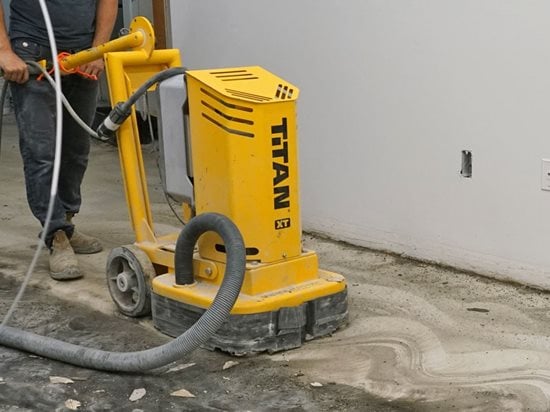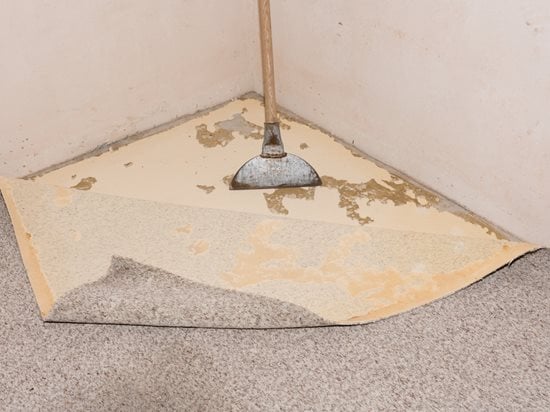- Concrete Cleaning Home
- Choosing a Concrete Cleaner or Degreaser
- How to Clean Exterior Concrete
- Concrete Cleaning Chemicals
- Pressure Washing Concrete
- Cleaning and Sealing Exterior Concrete: A Guide to Maintaining and Caring for Exterior Decorative Concrete of all Types
- Tips for Maintaining Exterior Concrete
- How to Clean Concrete
- How to Clean Concrete Floors
- How to Clean a Concrete Patio
- Cleaning a Concrete Driveway
- Cleaning Stamped Concrete
- Pool Deck Cleaning
- How to Clean Concrete Countertops
- How to Remove Stubborn Stains and Discoloration
- Advice on Cleaning Concrete Countertops, from Concrete-Countertops.org
- Related Information:
- Concrete Sealers
How to Remove Carpet Glue from Concrete Floors
When pulling up carpet or tile from a concrete floor, you’ll probably find glue residue left on the surface. Here are tips for removing it safely and efficiently.Are you dreaming of ripping up your ugly carpeting, ceramic tile, or sheet vinyl and making the switch to decorative concrete floors? That dream can quickly turn into a nightmare if you encounter a concrete surface covered with stubborn tile or carpet glue after taking up the floor covering. Removing that dried-on gunk can be a big undertaking, especially if the glue has been there for years. But if you plan to color the concrete with a stain or dye, it’s a necessary step to ensure uniform and complete color penetration (see Preparing Floors for Concrete Staining).
Find concrete cleaning contractors near me
The good news is that removing glue from a concrete floor is possible if you use the right tools and methods to get the job done. There are a number of strategies you can try, depending on the size of your floor and the type and amount of glue you encounter. For small residential concrete floor surfaces, glue removal is often a project you can tackle yourself with some hard work and perseverance.
1. Grab a scraper
If there’s not a lot of residual glue remaining on the concrete subfloor, it’s often possible to scrape it off using a long-handled floor scraper and then sweep it up for disposal. This method requires a lot of grunt work, and you have to be careful not to gouge or scratch the floor surface with the scraper blade. But even if you can’t remove every bit of glue from the concrete surface with this step alone, it will be easier to get rid of the rest by one of the other methods.
2. Boil some water
If the glue is water-based, you may be able to simply boil a pot of water and apply it to the dry glue to soften it. This method costs nothing and is chemical-free, so it’s worth a try as long as you’re careful not to splash the hot water onto yourself when pouring it onto the floor surface. Allow the water to soften the glue for a few minutes, and then scrub the glue off before it cools with a rotary floor scrubber or go back at it with the scraper.
Although some people claim to have success removing carpet glue from concrete using hot water mixed with vinegar or citrus-based cleaners, these solutions should be avoided because they can react with the concrete and etch the surface.
3. Apply a glue and mastic remover
If scraping and hot water don’t do the trick, there are a number of eco-friendly mastic removers you can use formulated specifically for removing old adhesive from concrete floors, such as GlueRemove from Surecrete and BLUE BEAR BEAN•e•doo 500MR Mastic Remover by Franmar (a soy-based solution). These low-odor, low-VOC products contain no harsh chemicals, so they are safe to use indoors. Plus, they will soften and emulsify most types of carpet glues and tile mastics, including solvent-based products. You typically apply these products to the floor with a pump-up sprayer, brush, or mop and allow them to sit until the mastic softens and can be scrapped away, anywhere from 45 minutes to several hours depending on the thickness of the glue or mastic buildup. Once most of the glue has been stripped, remove the remaining residue using a concrete cleaner or degreaser and a scrub brush, mop, or rotary floor scrubber.
Tip: Before buying an adhesive remover, be sure to read the label on the container to find out what substances the product will work on. Strippers formulated for removing paint from concrete aren’t intended to remove glues and mastics. It’s also a good idea to test the adhesive remover you plan to use on a small area of the floor to make sure it’s effective and won’t darken the concrete or inhibit stain penetration.

A machine like the Titan XT is a powerful solution for removing glue from concrete. WerkMaster in Burnaby, BC Canada.
4. Use mechanical methods
If chemical strippers are ineffective at removing glues and mastics – even after repeated applications – you may have to resort to mechanical removal methods, such as using a floor sander or buffer fitted with a sanding disk for the main part of the floor and a handheld grinder along the walls and in the corners. This is the fastest and most efficient method for removing glue residue from large floor surfaces. The problem is that sanding or grinding too aggressively can leave swirl marks in the concrete and expose some of the aggregate. It can also remove a layer of the cement paste from the surface, which will cause the stain to react differently.
If you plan to polish your concrete floor rather than stain it, grinding the mastic or adhesive off versus using a chemical stripper is a great option. But be sure to use grinding accessories specifically intended for this purpose. You can’t use the same type of diamond abrasives you use for polishing because they will cause the mastic to heat up, become gummy, and stick to the diamonds. Because of the aggressive nature of some concrete grinding machines, this is a job best done by a professional who has experience operating the equipment and knows the proper abrasive attachments to use to get the desired results.
 All-Purpose Concrete Cleaner
Removes sealers and coatings.
All-Purpose Concrete Cleaner
Removes sealers and coatings.
 Cleaner & Degreaser
Starting at $11.95
Cleaner & Degreaser
Starting at $11.95
 Brickform Neutra Clean
A pH neutral cleaner that combines cleaning and light degreasing
Brickform Neutra Clean
A pH neutral cleaner that combines cleaning and light degreasing
 Commercial Surface Cleaners
Cuts through grease and grime. Environmentally friendly
Commercial Surface Cleaners
Cuts through grease and grime. Environmentally friendly
Resurface the floor with an overlay or coating
If you have tried both chemical and mechanical methods to remove stubborn carpet glue and mastics but your efforts were unsuccessful, you can still make the switch to a decorative concrete floor by installing an overlay or epoxy coating over the existing concrete surface. Concrete overlays will hide defects, cover up exposed aggregate, and provide a brand new surface ideal for staining, polishing, and other decorative treatments.
Another reason to cover your floor with an overlay is if you have old linoleum or vinyl flooring that has been glued down with a black-colored adhesive. This black mastic, also called “cutback adhesive,” was most commonly used in homes built before the 1980s and could contain asbestos. Cutback adhesive is safe if left alone or encapsulated by new flooring, but it can be dangerous if you attempt to grind or scrape it off manually.
Call a professional
Removing carpet glue and tile mastics from concrete floors can be messy, time consuming, and labor intensive. But you shouldn’t let it stop you from making the switch to decorative concrete. Try out different approaches and take the appropriate precautions. If you are unable to remove the glue or you’re dealing with a large residential or commercial floor, contact a professional to do the job.
Related:
Remove Paint from Concrete
How to Remove Oil from Concrete





